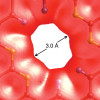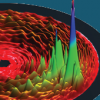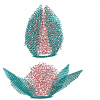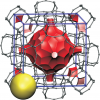Chemistry & Materials Science
Simulation plays an indispensable role in efforts to understand, predict, and ultimately control matter and energy at the electronic, atomic, and molecular levels. The goal is to provide new or improved materials for use in a wide variety of applications, especially for clean future energy technologies.
Perhaps most exciting is the hugely important trend torward miniaturization in nearly all kinds of materials and the burgeoning area of nanotechnology.
Science drivers include basic and grand challenges in nanostructures, nanorods, nanowires, nano-confined fluids, nuclear fuel materials, novel alloys, quantum dots, superconductors, catalysts, metallic liquids and glasses, ceramics, and more.
Applications inclulde low-emissions combustion, gas separation, hydrogen storage, batteries, fuel cells, power generating turbines, low-power computing, solid-state lighting, electrical energy storage, photovoltaics, tribology, optoelectronics, molecular electronics, superconductivity, and nanophotonics.
A key characteristic is the synergy between molecular simulation carried out at NERSC and experimention carried out at important facilities such as the LBNL Molecular Foundry.
Greenhouse Gases Converted to Fuel
A computational study has identified the mechanism of the electrochemical reduction of the greenhouse gas
carbon dioxide to small molecules such as formic acid,
formaldehyde, and methanol.
Read More »
Promise for Onion-Like Carbons as Supercapacitors
Molecular Dynamics has, for the first time, explained the relationship between capacitance and electrode potential in supercapacitors composed of onion-like carbons (OLCs). Supercapacitors are a novel class of energy storage devices that store charge in two closely spaced electrochemical layers. Read More »
Graphene as the Ultimate Membrane for Gas Separation
Graphene, a single-atom–thick flat sheet of carbon atoms, is prized for its range of extraordinary properties. It is useful for products ranging from computer displays to solar cells. But now electronic structure computations carried out solely at NERSC suggest a new role for this impressive material. Read More »
Quantum Dynamics of Elementary Reactions in the Gas Phase and on Surfaces
These elementary reactions are often at the heart of important processes in combustion and catalysis.
Read More »
Transport and Self-Assembly in Molecular Nanosystems
This project marries chemistry, fluid mechanics, mechanical engineering, physics, and computation to explore a veritable universe of fascinating nanostructures. Read More »
Speeding Up Zeolite Evaluation for Carbon Capture
Inspection of the structure and the void space of a porous material is a critical step
in most computational studies involving guest molecules. A new method developed at NERSC allows automated detection of inaccessible void spaces. Read More »













